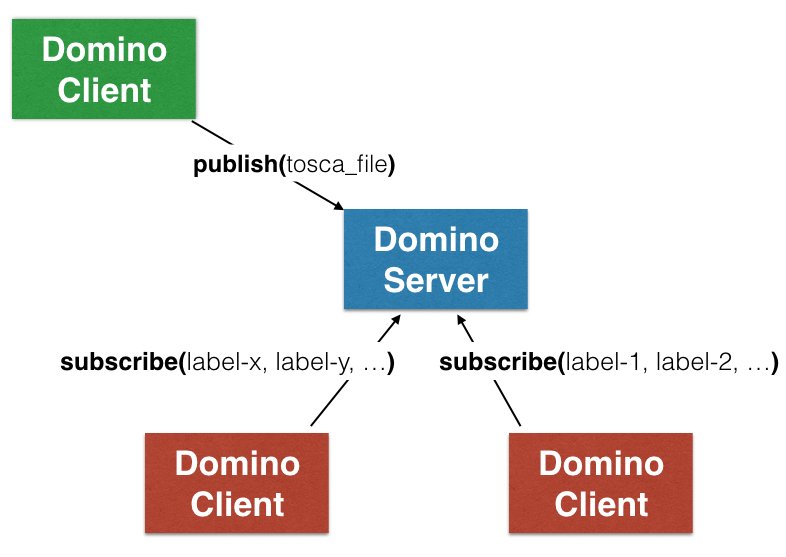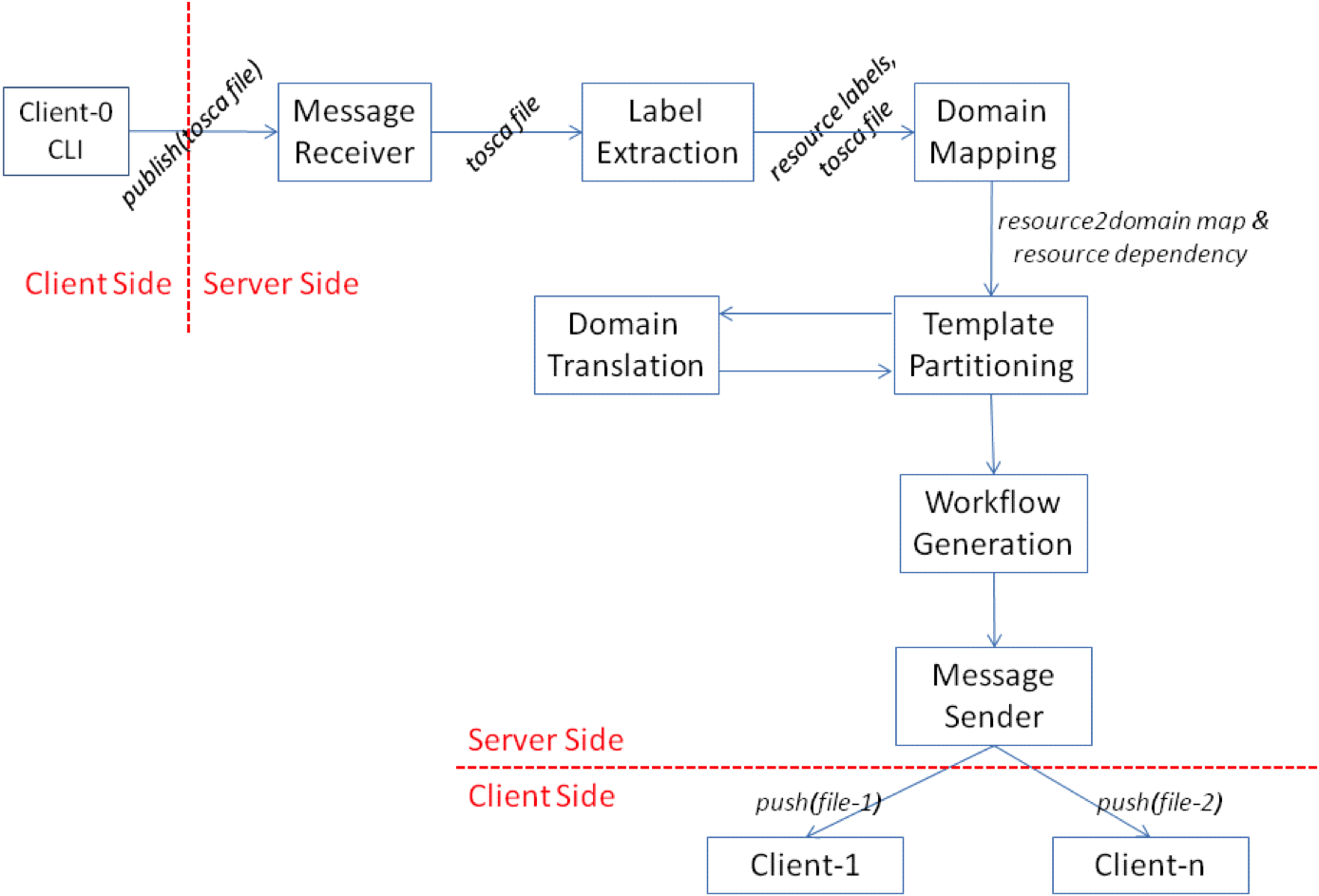Domino Project Overview¶
Domino Description¶
Domino provides a distribution service for Network Service Descriptors (NSDs) and Virtual Network Function Descriptors (VNFDs) that are composed using Tosca Simple Profile for Network Functions Virtualization (http://docs.oasis-open.org/tosca/tosca-nfv/v1.0/tosca-nfv-v1.0.html). Domino service is targeted towards supporting many Software Defined Network (SDN) controllers, Service Orchestrators (SOs), VNF Managers (VNFMs), Virtual Infastructure Managers (VIMs), Operation and Business Support Systems that produce and/or consume NSDs and VNFDs.
Producers of NSDs and VNFDs use Domino Service through Service Access Points (SAPs) or End Points (EPs) to publish these descriptors. Consumers of NSDs and VNFDs subscribe with the Domino Service through the same SAPs/EPs and declare their resource capabilities to onboard and perform Life Cycle Management (LCM) for Network Services (NSs) and Virtual Network Functions (VNFs). Thus, Domino acts as a service broker for NSs and VNFs modeled in a Tosca template.
Domino Capabilities and Usage¶
Labels in Domino¶
Domino’s pub/sub architecture is based on labels (see Fig. 1 below). Each Template Producer and Template Consumer is expected to run a local Domino Client to publish templates and subscribe for labels.
Domino Service does not interpret what the labels mean. Domino derives labels directly from the normative definitions in TOSCA Simple YAML Profile for NFV. Domino parses the policy rules included in the NSD/VNFD, form “policy” labels, and determine which resources are associated with which set of labels. Domino identifies which Domino Clients can host which resource based on the label subscriptions by these clients. Once mapping of resources to the clients are done, new NSDs/VNFDs are created based on the mapping. These new NSDs/VNFDs are translated and delivered to the clients.
Label Format and Examples¶
Domino supports policy labels in the following form:
<policytype>:properties:<key:value>
Orchestrators, controllers, and managers use Domino service to announce their capabilities by defining labels in this form and subscribing for these labels with the Domino Server.
For instance a particular VIM that is capable of performing an affinity based VNF or VDU placement at host machine granularity can specify a label in the form:
tosca.policies.Placement.affinity:properties:granularity:hostlevel
When the VIM registers with the Domino Service and subscribed for that label, Domino views this VIM as a candidate location that can host a VNF or VDU requesting affinity based placement policy at host machine granularity.
Another use case is the announcement of lifecycle management capabilities for VNFs and VNF Forwarding Graphs (VNFFG) by different SDN Controllers (SDN-Cs), VNFMs, or VIMs. For instance
tosca.policies.Scaling.VNFFG:properties:session_continuity:true
can be used as a label to indicate that when a scaling operation on a VNFFG (e.g., add more VNFs into the graph) is requested, existing session can still be enforced to go through the same chain of VNF instances.
To utilize Domino’s domain mapping services for virtual network resources (e.g., VNF, VDU, VNFFG, CP, VL, etc.), a network service or network function request must include policy rules that are composed of policy types and property values that match to the label announcements made by these domains. For instance, when a TOSCA template includes a policy rule with type “tosca.policies.Scaling.VNFFG” and property field “session_continuity” set as “true” targeting one or more VNFFGs, this serves as the hint for the Domino Server to identify all the Domain Clients that subscribed the label “tosca.policies.Scaling.VNFFG:properties:session_continuity:true”.
Template Example for Label Extraction¶
Consider the following NSD TOSCA template:
tosca_definitions_version: tosca_simple_profile_for_nfv_1_0_0
description: Template for deploying a single server with predefined properties.
metadata:
template_name: TOSCA NFV Sample Template
policy_types:
tosca.policies.Placement.Geolocation:
description: Geolocation policy
derived_from: tosca.policies.Placement
topology_template:
node_templates:
VNF1:
type: tosca.nodes.nfv.VNF
properties:
id: vnf1
vendor: acmetelco
version: 1.0
VNF2:
type: tosca.nodes.nfv.VNF
properties:
id: vnf2
vendor: ericsson
version: 1.0
VNF3:
type: tosca.nodes.nfv.VNF
properties:
id: vnf3
vendor: huawei
version: 1.0
policies:
- rule1:
type: tosca.policies.Placement.Geolocation
targets: [ VNF1 ]
properties:
region: [ us-west-1 ]
- rule2:
type: tosca.policies.Placement.Geolocation
targets: [ VNF2, VNF3 ]
properties:
region: [ us-west-1 , us-west-2 ]
Domino Server extracts all possible policy labels by exhaustively concatenating key-value pairs under the properties section of the policy rules to the policy type of these rules:
tosca.policies.Placement.Geolocation:properties:region:us-west-1
tosca.policies.Placement.Geolocation:properties:region:us-west-2
Furthermore, Domino Server iterates over the targets specified under policy rules to generate a set of labels for each target node:
required_labels['VNF1'] = { tosca.policies.Placement.Geolocation:properties:region:us-west-1 }
required_labels['VNF2'] = { tosca.policies.Placement.Geolocation:properties:region:us-west-1 , tosca.policies.Placement.Geolocation:properties:region:us-west-2}
required_labels['VNF3'] = { tosca.policies.Placement.Geolocation:properties:region:us-west-1 , tosca.policies.Placement.Geolocation:properties:region:us-west-2}
When a Template Consuming site (e.g., VNFM or VIM) registers with the Domino Server using Domino Client, it becomes an eligible candidate for template distribution with an initially empty set of label subscriptions. Suppose three different Domino Clients register with the Domino Server and subscribe for some or none of the policy labels such that the Domino Server has the current subscription state as follows:
subscribed_labels[site-1] = { } #this is empty set
subscribed_labels[site-2] = { tosca.policies.Placement.Geolocation:properties:region:us-west-1 }
subscribed_labels[site-3] = { tosca.policies.Placement.Geolocation:properties:region:us-west-1 , tosca.policies.Placement.Geolocation:properties:region:us-west-2}
Based on the TOSCA example and hypothetical label subscriptions above, Domino Server identifies all the VNFs can be hosted by Site-3, while VNF1 can be hosted by both Site-2 and Site-3. Note that Site-1 cannot host any of the VNFs listed in the TOSCA file. When a VNF can be hosted by multiple sites, Domino Server picks the site that can host the most number of VNFs. When not all VNFs can be hosted on the same site, the TOSCA file is partitioned into multiple files, one for each site. These files share a common part (e.g, meta-data, policy-types, version, description, virtual resources that are not targeted by any policy rule, etc.). Each site specific file has also a non-common part that only appears in that file (i.e., virtual resources explicitly assigned to that site and the policy rules that accompany those virtual resources.
In the current Domino convention, if a VNF (or any virtual resource) does not have a policy rule (i.e., it is not specified as a target in any of the policy rules) and it also is not dependent on any VNF (or any virtual resource) that is assigned to another site, that resource is wild carded by default and treated as part of the “common part”. Also note that currently Domino does not support all or nothing semantics: if some of the virtual resources are not mappable to any domain because they are targets of policy rules that are not supported by any site, these portions will be excluded while the remaining virtual resources will be still be part of one or more template files to be distributed to hosting sites. When NSDs and VNFDs are prepared, these conventions must be kept in mind. In the future releases, these conventions can change based on the new use cases.
For the example above, no partitioning would occur as all VNFs are mapped onto site-3; Domino Server simply delivers the Tosca file to Domino Client hosted on site-3. When TOSCA cannot be consumed by a particular site directly, Domino Server can utilize existing translators (e.g., heat-translator) to first translate the template before delivery.
Internal Processing Pipeline at Domino Server¶
Fig. 2 shows the block diagram for the processing stages of a published TOSCA template. Domino Client issues an RPC call publish(tosca file). Domino Server passes the received tosca file to Label Extractor that outputs resource labels. Domain Mapper uses the extracted labels and tosca file to find mappings from resources to domains as well as the resource dependencies. Resource to domain mappings and resource dependencies are utilized to partition the orchestration template into individual resource orchestration templates (one for each domain). If a translation is required (e.g., TOSCA to HOT), individual resource orchestration templates are first translated and then placed on a template distribution workflow based on resource dependencies. Message Sender block in the server takes one distribution task at a time from the workflow generator and pushes the orchestration template to the corresponding Domino Client.
Resource Scheduling¶
Domino Service currently supports maximum packing strategy when a virtual resource type can be hosted on multiple candidate sites. Initially, Domino Scheduler identifies virtual resources that has only one feasible site for hosting. Each such virtual resource is trivially assigned to its only feasible site. The remaining virtual resources with multiple candidate locations are sequentially allocated to one of their candidate locations that has the most virtual resource assignments so far. Note that wildcarded resources are assigned to all sites. To prevent wildcarding within the current release, (i) all sites must subscribed to a base policy with a dummy key-value pair defined under the properties tab and (ii) all the independent resources must be specified as target of that policy in NSD or VNFD file.


